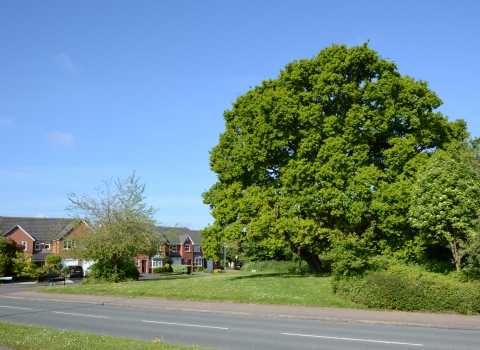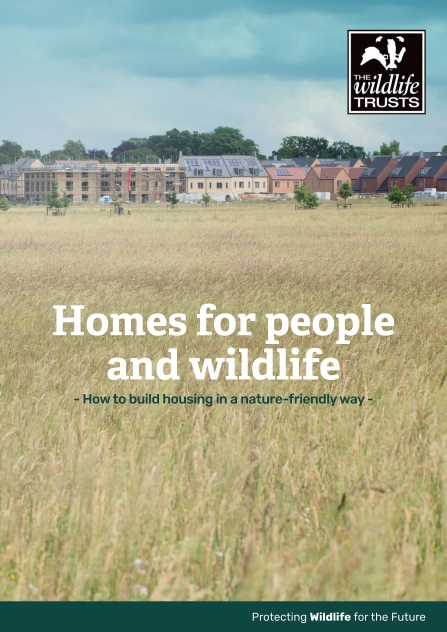Development can cause serious harm to wildlife but it doesn't have to; with careful thought, new development can deliver valuable biodiversity enhancement.
Our planning role is about promoting positive outcomes, not just about fighting harmful proposals. We are committed to working in partnership with planners, developers, communities and other environmental bodies across Worcestershire to ensure that the development decisions made are as environmentally sustainable as possible. We campaign for the inclusion of wildlife in the decision-making process and aim to ensure that biodiversity is fully considered in every planning application.
We are not anti-development and are acutely aware of the need for economic growth. We do not believe that development is necessarily bad; there are situations where the sensitive re-use of a site can provide significant benefit for wildlife. We aim to ensure that such benefits are realised whilst striving to reduce the damaging results of poor planning decisions. The principles for this are set out in The Wildlife Trusts' Housing Vision.
Our input is based on objective evidence and our understanding of the legislation and policy underpinning planning today. We work hard to ensure that our advice to Local Authorities is both independent and as accurate as possible. This is particularly relevant because Local Authorities are required by law to take wildlife into account in every decision they make. By working in partnership with them and other stakeholders we can help to ensure that they fulfill their responsibilities and help us to carry forward the conservation agenda.
We are dismayed at the outcome of the Public Inquiry of November 2023 into the Orchard Farm development of 300 houses immediately adjacent to our Tiddesley Wood nature reserve near Pershore. Please read our reaction for more information.
Our response to the Planning White Paper 2020
We believe that nature's recovery should be a key consideration in all planning decisions and that any changes to the planning system must strengthen protection for wildlife and give more priority to nature in and around new development. Sadly, we believe that the proposals set out in the Government's recent consultation will make it harder to protect and enhance wildlife across our county.
The proposed changes are described in the Government's Planning White Paper 'Planning for the Future', which was out for consultation until October 29th. As written, the proposed changes fail to address climate change, the ecological emergency and growing health inequalities. In fact, we think that if implemented as suggested, the changes will make it almost impossible for us to deliver a network of green places and corridors to help nature to recover and would mark a huge step backward for nature conservation. We therefore joined Wildlife Trusts across the country to persuade Government to make sure that nature’s recovery is embedded in any change to the planning system. Our UK planning team used examples from Trusts across England (including Worcestershire) to help make the case for a better way forward.
You can find out more about the background to the proposals in this blog by Dr. Sue Young, Head of Land Use Planning and Ecological Networks at The Wildlife Trusts, read a preliminary analysis of the risks posed by the White paper in The Wildlife Trusts' Preliminary Analysis Of The Planning White Paper and read The Wildlife Trusts' combined response to the consultation to find out what we said.
Planning help and advice
You can find out more about how we engage with the planning process in the Trust's Planning Policy and there is some guidance on how you can best comment on applications near you in our our Planning for Biodiversity document.
If you have a specific planning query please contact the Trust's Senior Conservation Officer - Planning Steven Bloomfield. If your question relates to a planning application it would be helpful if you could include the application number in your email.
The National Planning Policy Framework
The National Planning Policy Framework was revised in July 2021. It replaces the previous NPPF and outlines the Government's policy for development in England and includes some important environmental provisions. A brief commentary on the relevant paragraphs can be found in our National Planning Policy Framework (NPPF) commentary.
Green infrastructure
The Trust is a key partner in Worcestershire's Green Infrastructure Partnership. We chair this important group, which aims to ensure that all new developments contribute positively to their local environment.
Green Infrastructure (GI) is a complex and growing area of work for local authorities and their partners. The short film below, by the Worcestershire Green Infrastructure Partnership, helps to illustrate what GI is and why we're passionate about its implementation in the county.
Green Infrastructure partnership video (https://youtu.be/etdPM_mUGK0)
Worcestershire Green Infrastructure Partnership video
Building with Nature
The Trust has been involved in the development of a new benchmarking system that aims to help developers and councils deliver high quality Green Infrastructure through development. The Building with Nature benchmark set out parameters by which new developments can be judged and provides guidance on integrating wildlife, water and public benefits into all new building projects.


